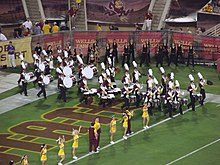

Drum - Cadence B
Drum - Four Flams Snare drum cadences performed by the United States Navy Band
Problems playing these files? See media help.
In music, a drum cadence or street beat is a work played exclusively by the percussion section of a modern marching band (see marching percussion). It is stylistically descended from early military marches, and related to military cadences, as both are a means of providing a beat while marching.
According to Hiro Songsblog a drum cadence is "'a drumline piece played in a parading marching band between or in place of full-band pieces'. Cadences are also: 'a chant that is sung by military personnel while parading or marching'."
Cadences employ the four basic drum strokes and often directly include drum rudiments. They have a wide range of difficulty, from simple accent patterns to complex rhythms including hybrid rudiments, and are played by virtually every modern drum line. Cadences are important from a performance standpoint, as a good drum cadence can make the band stand out from the rest in competition. Field shows are often preceded by the band marching to the beat of the cadence.
Marching percussion generally consists of at least snare drums, tenor drums, cymbals, and bass drums, and may include timpani.
See also
Sources
- "Drum cadences and drumline sheet music", Hiro Songsblog.
- "What Is a Drumline Cadence?". Wisegeek.com. Conjecture Corporation. Retrieved 27 November 2012.
Further reading
- Maroni, Joe (2008). The Drum Cadence Book. ISBN 978-0-7866-3391-3.
External links
- "How to Write a Drum Cadence", wikiHow.com.
| Drum beats and strokes | |
|---|---|
This music theory article is a stub. You can help Misplaced Pages by expanding it. |